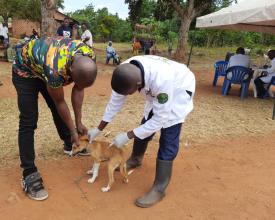
Comment les cliniques de culture et d'élevage font progresser One Health

Dans les pays à faible revenu, les services de conseil aux agriculteurs sont peu nombreux, ce qui fait que les petits exploitants sont mal desservis. Le travail de CABI avec les cliniques végétales a révélé les avantages potentiels de l'initiative "One Health" en élargissant le champ d'action des cliniques végétales pour mieux répondre aux demandes de conseils des agriculteurs. Pour explorer ce potentiel, des "cliniques de culture et d'élevage" ont été créées dans six districts de l'Ouganda en 2021. Ces "cliniques communes" apportent une valeur ajoutée à l'offre One Health de plusieurs manières : 1) le personnel chargé des cultures et de l'élevage partage les coûts opérationnels, les connaissances et les idées d'une manière qu'il n'est normalement pas en mesure de faire ; 2) les consultations sur les plantes et l'élevage au même endroit permettent aux agriculteurs de gagner du temps et offrent des possibilités d'apprentissage croisé entre les agriculteurs et le personnel de la clinique ; 3) les cliniques conjointes sont un point d'entrée pour améliorer les systèmes d'orientation et cibler la livraison de technologies telles que les vaccins pour animaux et les boutures de manioc propres ; et 4) elles offrent une nouvelle voie pour découvrir ce que les agriculteurs savent et ne savent pas sur les questions liées à One Health - des informations cruciales pour la conception de solutions.
Impacts
Les agriculteurs sont confrontés à de multiples problèmes liés à la santé et à la production de leurs cultures et de leur bétail, et plusieurs de ces problèmes sont interdépendants et affectent également la santé des personnes et l'environnement. Les cliniques de cultures et d'élevage apportent une valeur ajoutée à la prestation de services existante, en faisant un meilleur usage des ressources et des capacités organisationnelles existantes, tout en servant les agriculteurs d'une manière plus intégrée. Exemples tirés de la première année pilote :
- Certains agents chargés de l'élevage ont apporté des vaccins contre la rage lors des séances cliniques afin de profiter de l'événement pour vacciner les chiens dans les environs.
- Au cours de la première année, environ 15 % des quelque 800 visiteurs de la clinique ont posé des questions à la fois sur les cultures et les animaux, et beaucoup sont restés pour écouter les consultations des autres agriculteurs et en tirer des enseignements.
- Sur la base des questions posées par les agriculteurs, le personnel de la clinique a ensuite organisé des campagnes de vaccination dans les villages (par exemple sur la maladie de Newcastle) et la distribution de boutures de manioc propres.
- Dans un district, un technicien du laboratoire d'élevage a recueilli des échantillons (urine, fèces, sang) lors des séances cliniques et les a ramenés au laboratoire, améliorant ainsi les procédures d'orientation. Les cliniques de culture et d'élevage permettent d'identifier et de traiter conjointement des problèmes de santé tels que les mycotoxines, les zoonoses, l'utilisation abusive de pesticides et de médicaments vétérinaires.

